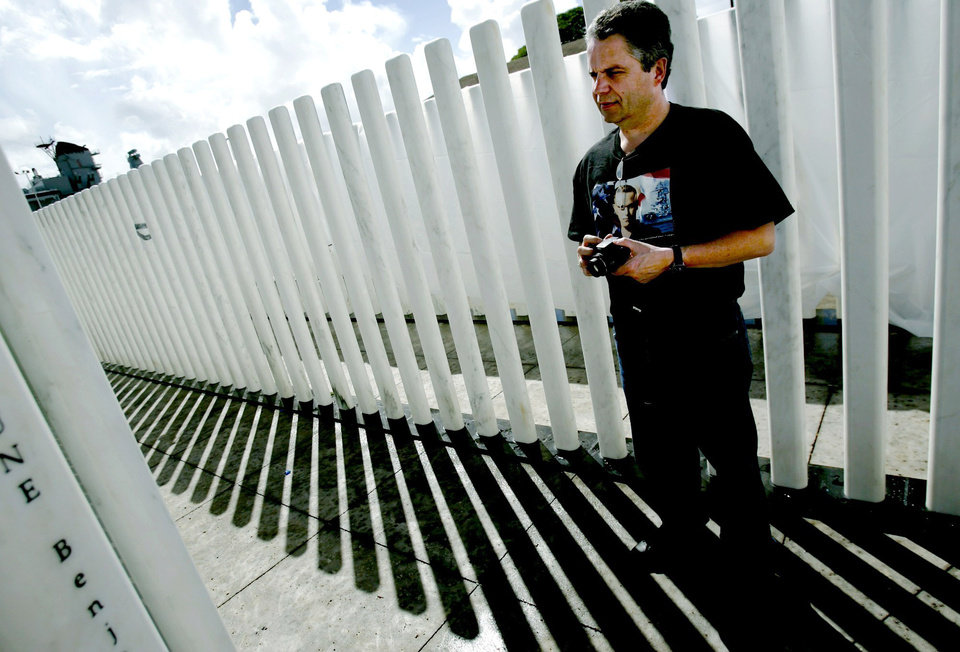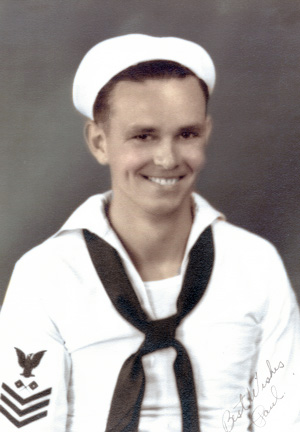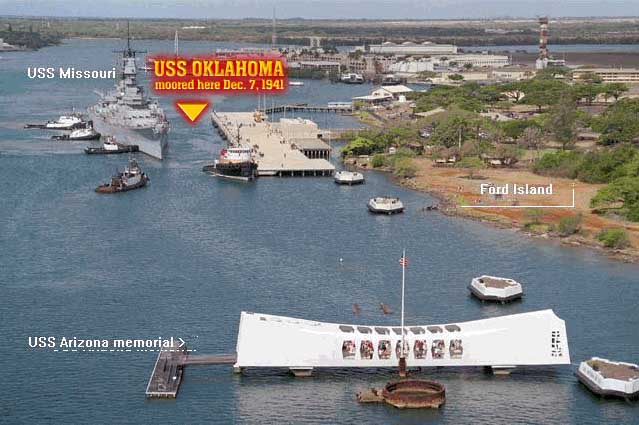
One man can make a difference
My name is Kevin King and I purchased a wonderful book written by my friend, Mr. Joe Todd, about the USS Oklahoma. Mr. Todd spent countless hours interviewing the surviving crew of the USS Oklahoma.
I decided it was high time to play tour guide for my young son and bride, and where better than Pearl Harbor, right? Well, when we got there, I was hit with a wave of disbelief. The USS Oklahoma was nowhere to be found—like it had pulled a Houdini or something. Instead, there was the USS Missouri, sitting there all proud on the very spot where the USS Oklahoma had been moored on that infamous morning of December 7, 1941. You’d think they could at least put up a “Sorry, the Oklahoma was here once” sign or something.
After getting my fill of the Mighty MO, I figured I’d pay my respects to the 429 crew members of the USS Oklahoma at the Punch Bowl National Cemetery. But here’s where things got interesting—or, you know, frustrating. I asked the groundskeepers where the crew was buried, and they looked at me like I was asking for directions to Narnia. They had no clue. None. Zilch.
So, after a wild goose chase, I found out after my trip that the crew was buried in mass graves. And get this: the markers simply said how many bodies were in each grave, followed by the lovely word “UNKNOWN.” Because clearly, labeling things correctly is too much to ask for.
Three ships didn’t make it out of that harbor alive after the Japanese attack.
USS Arizona (BB-39) 1,177 officers and crewmen
USS Oklahoma (BB-37) 429 Officers and crewmen
USS Utah (BB-31) 64 officers and men
The Arizona and the Utah are still located in Pearl Harbor today with their crew entombed. Only the USS Oklahoma was removed and sold for scrap.
I decided it was high time someone put up a marker at the Missouri to shout out, “Hey, the USS Oklahoma was here first!” during the battle for Pearl Harbor. Because, you know, history.
So in 2000 I set up a meeting with a local businessman in Oklahoma City, Mr. P.B. Odom III. He listened to my grand idea, gave me a nod, and told me to write a letter of intent. He’d make sure it got into the hands of the right government folks. Sounds official, right? His daughter, Rachel, even proofread my letter and sent it off—because if there’s one thing that’ll get the government moving, it’s a perfectly proofread letter.
I started writing to the White House, Congress, and the US Senate demanding a historical sign to announce the presence of this once-proud battleship. I wanted every tourist at Pearl Harbor to know the truth: the USS Oklahoma wasn’t just some ship. It was THE ship. But, I realized that if I was going to make this happen, I needed to rally some local troops.
Next thing I know, I’m invited to share my story with a group of local businessmen, thanks to a state senator who thought this might be worth their time. And just like that, a committee was born that same year.
But why stop there? I bought the domain www.ussoklahoma.com,” and went full road warrior, traveling across the country to attend USS Oklahoma reunions. I met the men who once stood on the teak deck of that ship, collected interviews like a historian with a caffeine addiction, and hoarded materials and photos like they were going out of style.
At one point, my Navy website was a beast—massive enough to enlighten the general public about the crew and the battleship because if the government wasn’t going to do it, I sure as heck was.

Paul Goodyear
I invited Mr. Paul Goodyear, a survivor of the USS Oklahoma, to come join the committee because he spearheaded the OKIE Survivors Association. I had met Mr Goodyear at a USS Oklahoma reunion.
Now, anytime you get a large group together, there’s bound to be some friction—like putting a bunch of cats in a room and expecting them to dance in sync. Some folks didn’t exactly see eye to eye on how things should be done. To keep the peace, we brought in a new member: the walking, talking conscience of our committee, Elayne Dennis. She was our secretary and an executive board member, but more importantly, she was the only one who could keep everyone from tearing each other apart. She was a pro at keeping minutes of our meetings and archiving every single email the co-chairs sent to the members. To this day, I still have all of them—because nothing says “fond memories” like a mountain of old emails.
Starting in 2000, the Memorial Committee actually began to make some progress. Just weeks before the groundbreaking ceremony on September 7, 2006, our two chairpersons thought, “Hey, why not complicate things further?” So, they invited Mr. Edward Vezey, another USS Oklahoma survivor, to join the group. Naturally, we had to bring him up to speed on the project—because who doesn’t love a good last-minute crash course?
Now, when you’ve got a big idea and you share it with others, they start to feel like they’re part owners, and suddenly, miracles start happening. People just seemed to have it in their hearts to help, which was great because, after five long years and over $20,000 of my personal funds, we finally started to attract some attention from the big leagues—U.S. Senator James Inhofe and Congressman Tom Cole of Oklahoma.
We needed their help to cut through all the red tape that comes with trying to build a large memorial on an active military base. Senator Inhofe sponsored a bill in the U.S. Senate. Congressman Cole not only supported it in the US House of Representatives, but also personally delivered it to President George W. Bush’s desk for signature. Talk about VIP service! Of course, the memorial had to be built within a certain timeframe because nothing says “government efficiency” like a ticking clock.
At that point, I had $1,800 left of my own money, so naturally, I threw a free WWII USO-style benefit concert featuring the legendary USO entertainer Anita Bryant, a choir, an orchestra, the 145th Army Band, and a WWII-style swing band, “The Talk of the Town.” We held the event at Crossroads Cathedral in Oklahoma City topped it off with a fireworks display, and somehow managed to raise over $50,000 for the memorial from donations at this free concert. Not too shabby!
In the end, the fine people of Oklahoma, along with The Oklahoma Centennial Commission under the direction of Mr. Blake Wade, managed to raise the $1.1 million needed to build the memorial. The dedication took place on December 7, 2007, during the Centennial Celebration of the great State of Oklahoma.
I took it upon myself to be in charge of transportation for the USS Oklahoma survivors and their families. I made sure they got safely to the dedication on an active military base at Pearl Harbor, and back to their hotels afterward—because nothing says “VIP treatment” like making sure no one gets left behind.
“After Years of hard work, we finally cracked open the champagne (and maybe a few Mai Tais) at a lavish Hawaiian Hotel banquet, because what’s a dedication without a luau-worthy party? The crew, now dubbed ‘The Unsung Heroes of Pearl Harbor,’ were finally honored and celebrated – and by celebrated, I mean fed an impressive amount of poke and kalua pig.”
In a move that was long overdue, the name USS Oklahoma was put on the unmarked graves of the crew – because, let’s be real, ‘Unknown’ is just a fancy way of saying ‘we forgot to ask for their ID’. And in a shocking twist, we rebranded the Arizona Memorial to include every ship in the harbor. Because, why have a memorial for just one ship when you can have a ‘Pearl Harbor Palooza’ – a celebration of all things sunk, damaged, or just plain lucky to have made it out alive?
It is now the Pearl Harbor Memorial.

